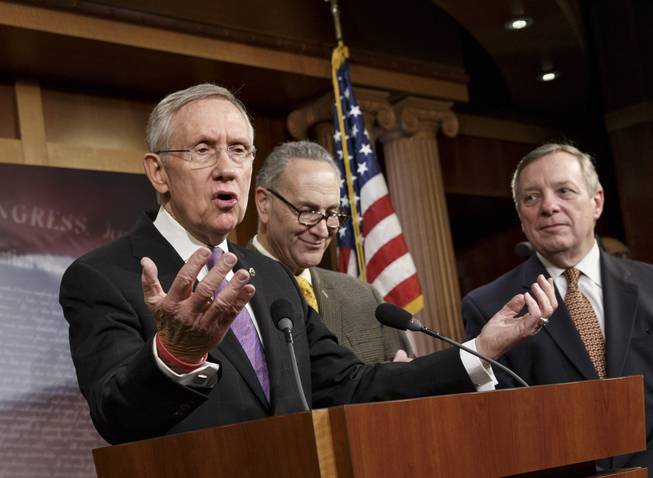
J. Scott Applewhite / AP
From left, Senate Majority Leader Harry Reid, D-Nev., Sen. Chuck Schumer, D-N.Y., and Senate Majority Whip Dick Durbin, D-Ill., talk to reporters about the final work of the Senate as their legislative year nears to a close, at the Capitol in Washington, Thursday, Dec. 19, 2013.
Tuesday, Dec. 31, 2013 | 2 a.m.
Sun coverage
The three-month unemployment insurance extension the Senate plans to vote on next week won’t make any changes to the current eligibility structure for federally backed emergency benefits.
But Senate Majority Leader Harry Reid is thinking about pushing to change how eligibility for emergency unemployment benefits is determined, making it easier for the long-term unemployed to access benefits as the economy improves.
Reid told the Las Vegas Sun during an interview Monday that he’d like to lower the per-tier unemployment rate threshold that determines when jobless workers in hardest-hit states can claim the maximum weeks of benefits.
“Hopefully, we can bring that number down,” Reid said during a telephone interview.
Right now, jobless workers are only eligible for the maximum duration of benefits — 73 weeks — if the state they are filing in has at least a 9 percent unemployment rate.
But pretty soon, there may be no states left in the country that are quite that bad off.
In November, only Nevada and Rhode Island had a 9 percent unemployment rate — exactly.
With much more sustained economic improvement, the country could end up in a situation where it has authorized up to 73 weeks of emergency unemployment benefits but no one in the country can claim all of them.
The loss of eligibility is not immediate: A state has to post a three-month average unemployment rate of less than 9 percent before its jobless workers can no longer apply for the final 10 weeks of emergency assistance, known as Tier 4. Eligibility calculations are done the same way for states teetering on the edge of Tier 3, where having an unemployment rate at or worse than 7 percent buys jobless workers an extra nine weeks of assistance, and Tier 2, where a threshold of 6 percent unemployment means an extra 14 weeks of benefits.
There are no requirements tied to the unemployment rate for jobless workers to be eligible for the 14 weeks of Tier 1 benefits that kick in after individuals have exhausted their first 26 weeks of benefits.
Congress set those thresholds in 2012, and since they have been in place, many states have seen their jobless workers’ eligibility for additional tiers of benefits expire as the state’s economic situation has improved.
But when asked if improving indicators meant the country may soon be ready for a reduction in the maximum availability of emergency unemployment benefits, Reid rejected the idea.
“During the Bush years, we had emergency unemployment insurance when it was 5.6 percent,” Reid said.
President George W. Bush authorized long-term jobless benefits in 2008, and though the availability and duration of benefits was expanded and later slightly contracted, federally funded extended benefits have been available since.
But in that time, only rarely has funding for the program been replenished without a fight.
The federal government foots the whole bill for emergency unemployment benefits, which right now are expected to cost about $25 billion for the year. That’s much less than the costs were during the height of the recession’s unemployment in 2010, when jobless benefits cost the government over $150 billion.
Advocates of the benefits say they’re well-spent dollars that go straight back into the economy. But others maintain they represent a bill the government can’t keep footing — and should allow to expire, if not by the inaction of Congress, then at least by attrition as states’ economies improve.
Rep. Mark Amodei, R-Nev., has been among those who have advocated for letting the upper tiers of unemployment benefits expire, arguing that the extended benefits were only meant to be a temporary boost to help jobless workers through the worst of the recession.
Numbers suggest that workers’ dependency on unemployment insurance is falling, nationally. While at the height of the recession the average length of time spent on unemployment rose to over 37 weeks, it is currently only 17.1 weeks. That is a national average, however, not an average that is necessarily reflective of the specific situation in Nevada. Nationally, the unemployment rate is also lower than it is in the Silver State, at just 7 percent.
Right now, nobody has emergency unemployment benefits, as the program was allowed to expire Dec. 28.
Reid already has pledged to have the Senate vote next week on a bill that would replenish funding for the program for three months. The vote on the legislation, drafted by Sens. Jack Reed, D-R.I., and Dean Heller, R-Nev., could be as early as Monday, and Reid has warned Republicans in the House not to follow suit at their political peril.
While many rank-and-file House Republicans, including Rep. Joe Heck, R-Nev., have asked leaders there to hold a vote on an unemployment extension, House Speaker John Boehner has promised no similar schedule to consider any legislation on the subject.
Reid is unlikely to raise the issue of recalibrating unemployment rate thresholds until after the present legislative hurdle is cleared.
“Let’s see if we can (help) the 1.3 million people around the country who are off of it as of Monday,” Reid said. “I hope that we can extend it for three months.”

Join the Discussion:
Check this out for a full explanation of our conversion to the LiveFyre commenting system and instructions on how to sign up for an account.
Full comments policy